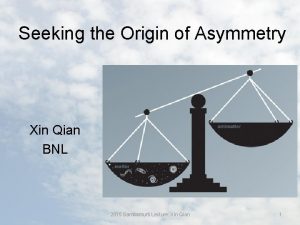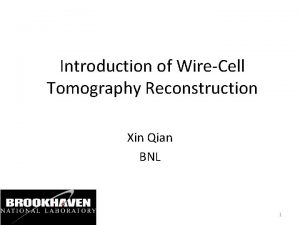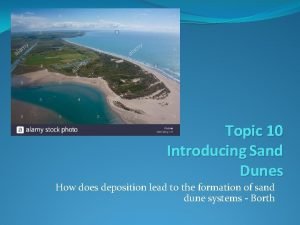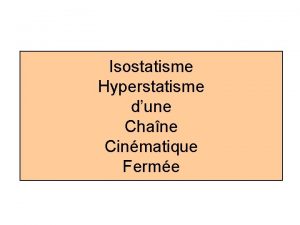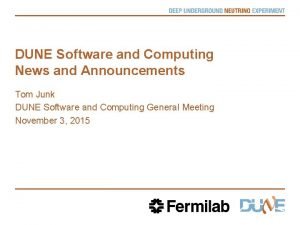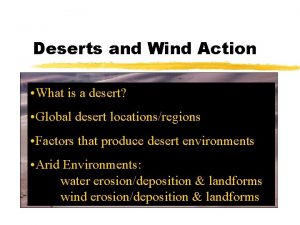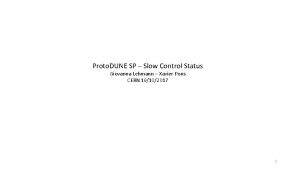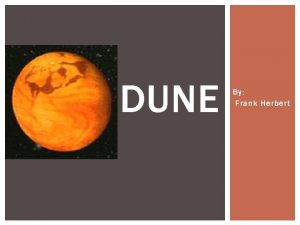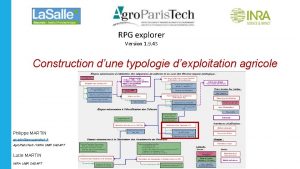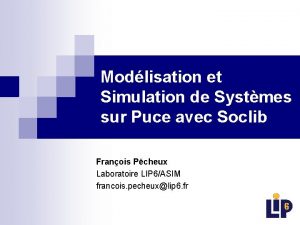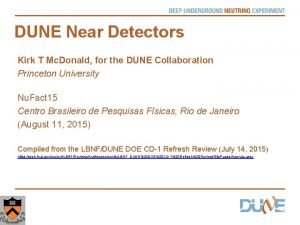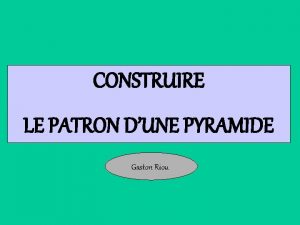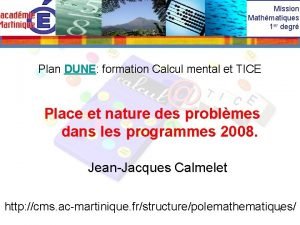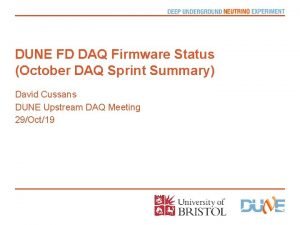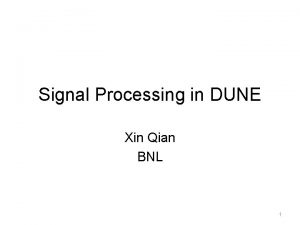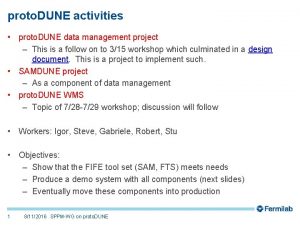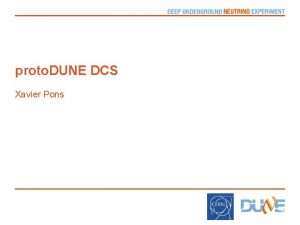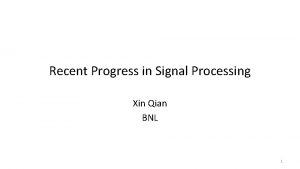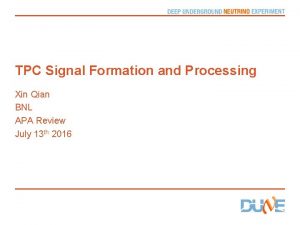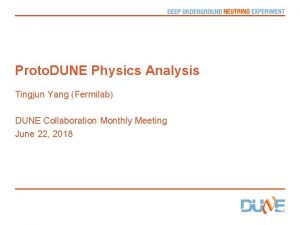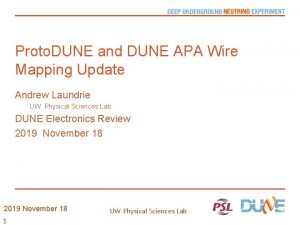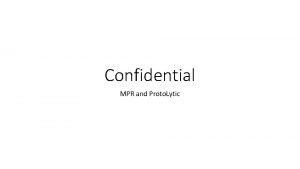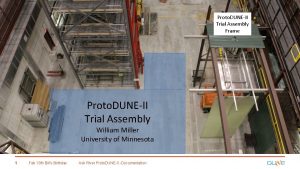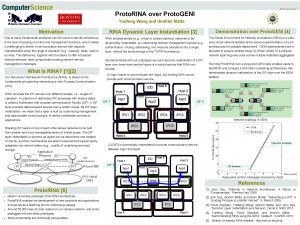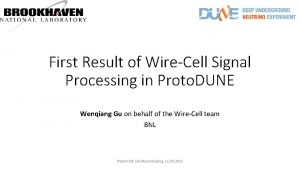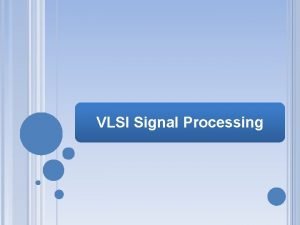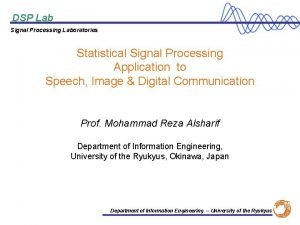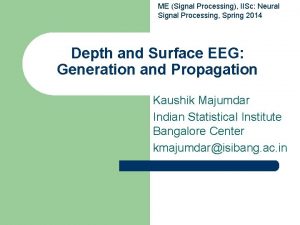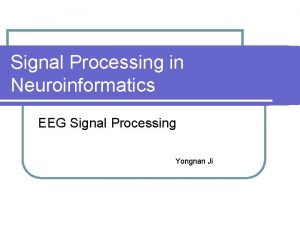Signal Processing Work for Proto DUNE Xin Qian























- Slides: 23

Signal Processing Work for Proto. DUNE Xin Qian, Chao Zhang, and Brett Viren BNL 1

Outline • Past experience of the team in Micro. Boo. NE • Thoughts on proto. DUNE signal processing • Work plan on proto. DUNE 2

Past experience of the Wire-Cell team in Micro. Boo. NE • Excess noise identification and filtering in Micro. Boo. NE – https: //arxiv. org/abs/1705. 07341 • Describing the new TPC signal processing algorithm: 2 D deconvolution + ROI – https: //arxiv. org/abs/1802. 08709 • Data/MC comparison and proper dealing with various detailed signal processing issues observed in Micro. Boo. NE TPC: demonstration of thorough understanding of the Micro. Boo. NE TPC – https: //arxiv. org/abs/1804. 02583 3

Excess Noise Filtering (1705. 07341) • Three major excess noise sources: – ASIC low-voltage regulator (low frequency coherent noise) – Cathode high voltage power supply (36, 108 … k. Hz) – Excess noise from PMT or other system (~900 k. Hz) 4

Excess Noise Filtering • In general, dealing with one particular excess of noise is straight forward. The challenges show up when there are multiple sources of excess of noise • Expect proto. DUNE’s excess of noise is much better than Micro. Boo. NE (lessons learned from previous experiments) 5

Non-functional Channels Other major issues that encountered in Micro. Boo. NE are • Saturation of ASICs due to movement of wires • Misconfigured channels (4. 7 m. V/f. C + 1. 0 us instead of 14 m. V/f. C + 2. 0 us) • “Sleeping” ASICs (due to start-up problem) All these should be much better in proto. DUNE, as Micro. Boo. NE’s experience provides feedback to improved preamp ASIC design 6

Evolution of Signal Processing in Micro. Boo. NE Drift time ~ 2 years of effort Wire number Two signal processing papers (~100 pages) to be submitted Field response is based on 2 D Garfield calculation, see Chao’s talk on LAr. FCS 7

New Signal Processing Procedure (1802. 08709) • The key in developing the new signal processing algorithm is realizing the induced signal is long-range – Leading to topology-dependent observed waveform • 2 D deconvolution taking into account both wire and time dimensions • Additional ROI algorithm + software filter to reduce impact of intrinsic noise 8

Highly non-trivial algorithm in defining Signal ROIs 9

Significant Improvements in Signal and Noise Simulation • In order to quantitatively evaluate the new signal processing chain, significant improvements in signal and noise simulation is needed: – New TPC signal simulation includes • Long-range of induced current beyond the closest wire (+-10 wires in Micro. Boo. NE) • Position-dependent induced current within a wire pitch (1/10 of the wire pitch) – New noise simulation utilizes • Rayleigh distribution of the noise magnitude in the frequency domain • Data-driven noise spectrum 10

Part II of Signal Processing Paper (1804. 02583) • Focus on the data/MC comparison in Micro. Boo. NE • Solutions to a few special signal processing issues encountered in Micro. Boo. NE – Pole-zero cancellation issue in preamp ASIC (much improved in proto. DUNE) – Signal processing in the shorted wire region (L 1 SP, do not expect such behavior in proto. DUNE) – ADC bit shift (happened in the data packing stage in Micro. Boo. NE after warm ADC) • Demonstration of the charge matching among three wire planes – Foundation of the Wire-Cell reconstruction paradigm (https: //arxiv. org/abs/1803. 04850) 11

Imperfect Electronics Response • Depending on the channels, the electronics response may contain long tails – Calibrated by the pulser data and corrected in the signal processing 12

Data/MC Comparison Parallel track Large angle track 13

Signal Processing in the shorted wire region (L 1 SP) • In the shorted-Y region, a collection type signal (unipolar) can show up in the induction wires (expecting a bipolar response) • The nominal signal processing would fail in this case leading to distorted deconvoluted signal • A special signal processing based on the compressed sensing technique is developed to deal with this case 14

Correction for ADC bit shift 15

Demonstration of Charge Matching • Since the same amount of ionization electrons are measured by each of the wire plane, the same should be reconstructed by different wire planes Point source Line source Foundation of the Wire-Cell reconstruction paradigm is demonstrated! 16

Charge Matching 17

Thoughts on proto. DUNE signal processing • proto. DUNE and Micro. Boo. NE share many common hardware elements – Most of them are improved based on lessons learned in Micro. Boo. NE – Expectations include: • • Much more uniform electronics response function Less non-functional preamp ASICs due to “start-up” problem Less misconfigured preamp ASICs No shorted wires Demonstration of <1% non-functional channels No saturations of preamp ASICs No excess noise due to cathode high voltage and low-voltage regulator 18

Thoughts on proto. DUNE signal processing • There also new hardware elements in proto. DUNE compared to Micro. Boo. NE – The cold ADC chip is not performing as desired • Stuck codes in ADC (some data is lost) – Need to deal with before the signal processing • Non-linearity in conversion between ADC and voltage – Need to be ‘calibrated’ (bench data vs. in-situ calibration) – As always, if there is one problem, it is relatively straight forward to deal with. If there are more, it is much harder to deal with • Best scenario: no shorted wires, no excess of noise, preamp ASICs are all properly configured only need to deal with the cold ADC problem (can design a in-situ calibration plan on this, next page) • Worst scenario: shorted wires + lots of excess noise + cold ADC problem may take many months of time to deal with 19

Thoughts of ADC Non-linearity Calibration • ADC nonlinearity is essentially a nonlinear conversion between voltage and the ADC value – In principle, the calibration is straight forward, if we know the input voltage, and measure the corresponding ADC values, we can build up this non-linearity curve • The challenges of calibration is coming from the fact that we do not have a simple known input voltage in-situ – Instead, we have the calibration pulser data, which go through the shaping of cold electronics, we have a (reasonably well-known) curve instead of known voltage – Tunable knobs include (gain and shaping time of cold preamp chip, calibration pulse height, starting time of the calibration pulse) • The last is important, as the digitization is performed at 2 MHz 20

Thoughts of ADC Non-linearity Calibration • Take data at different calibration pulse gains and different starting time (assuming fixed gain and shaping time for the cold preamp) • Pick up the data at the same ADC codes (same ADC nonlinearity) • Correct gain for the data in order to map out the electronics response function – Combine data at different ADC codes to be more efficient • Use the calibrated electronics response function to calibrate the ADC nonlinearity (different ADC codes) • Use the nonlinearity curve in the signal processing 21

Work plan for proto. DUNE (I) • Signal processing code (deconvolution + ROI) is available in larsoft – Need to be properly configured for proto. DUNE usage • Integration of full TPC signal and noise simulation is almost ready – Need to be configured for proto. DUNE to test the signal processing code in simulation • Need a new module prepared for excess noise filtering and ADC-related correction 22

Work Plan for Proto. DUNE (II) • Connect the signal processing code with existing simulation – Figure out some basic parameters , channel mapping, multiple APAs, time length and other inputs … • Replace the existing simulation with improved TPC signal/noise simulation – Allows for quantitative checks on the signal processing • Prepare the new module for ADC mitigation and excess noise filtering – Auxiliary tools: event displays for experts, channel mapping … • Prepare for the worst, and hope for the best 23
 Xin qian bnl
Xin qian bnl Wirecell
Wirecell Baseband signal and bandpass signal
Baseband signal and bandpass signal Baseband signal and bandpass signal
Baseband signal and bandpass signal Digital signal as a composite analog signal
Digital signal as a composite analog signal Even part of signal
Even part of signal Desert pavement definition
Desert pavement definition How are sand dunes formed
How are sand dunes formed Climax
Climax Dune ddl
Dune ddl Dunesoftware
Dunesoftware In the desert, ephemeral streams _____.
In the desert, ephemeral streams _____. Dune sp
Dune sp Plan de dissertation juridique
Plan de dissertation juridique Bene gesserit
Bene gesserit Rpg explorer
Rpg explorer La dune clib
La dune clib Dune
Dune Patron dune pyramide
Patron dune pyramide Ameen rihani
Ameen rihani Plan dune
Plan dune Coastal deposition diagram
Coastal deposition diagram Ppe edinburgh university
Ppe edinburgh university Dune firmware
Dune firmware
